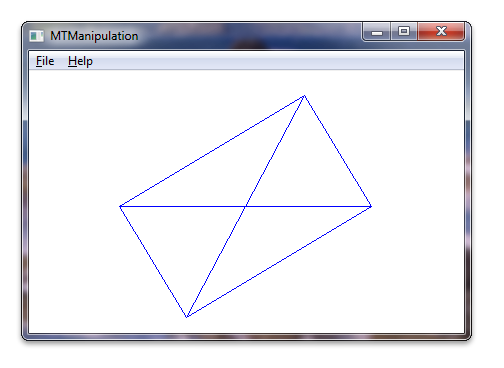Windows-Touchbearbeitungsbeispiel (MTManipulation)
In diesem Abschnitt wird das Beispiel für die Windows-Touchbearbeitung beschrieben.
Das Windows-Beispiel für Touchbearbeitung veranschaulicht, wie ein Objekt mithilfe der IManipulationProcessor-Schnittstelle und der Implementierung einer _IManipulationEvents Ereignissenke übersetzt, gedreht und skaliert wird. Der folgende Screenshot zeigt, wie das Beispiel aussieht, wenn es ausgeführt wird.

Für dieses Beispiel wird eine CDrawingObject-Klasse erstellt, die programmgesteuert übersetzt, gedreht oder skaliert werden kann. Eine IManipulationProcessor-Schnittstelle wird instanziiert. Es wird eine Manipulationsereignissenke erstellt, die einen Zeiger auf die CDrawingObject-Klasse und die IManipulationProcessor-Schnittstelle in ihrem Konstruktor akzeptiert. In der Implementierung der Manipulationsereignissenke wird ein Verbindungspunkt mit dem IManipulationProcessor erstellt, sodass vom IManipulationProcessor ausgelöste Ereignisse von der Ereignissenke empfangen werden. Touchdaten werden der IManipulationProcessor-Schnittstelle zugeführt, und die Schnittstelle löst dann _IManipulationEvent Ereignisse aus. Die Ereignishandler in der CManipulationEventSink-Klasse aktualisieren die Ausrichtung des CDrawingObject durch Aufrufen von Accessoren auf den Zeiger auf das CDrawingObject.
Der folgende Code zeigt, wie das Fenster für touch eingerichtet ist und wie CDrawingObject und IManipulationProcessor instanziiert und an den CManipulationEventSink-Konstruktor übergeben werden.
CDrawingObject g_cRect; // CDrawingObject class holds information about the rectangle
// and it is responsible for painting the rectangle.
(...)
BOOL InitInstance(HINSTANCE hInstance, int nCmdShow)
{
(...)
// Register application window for receiving multi-touch input. Use default settings.
if (!RegisterTouchWindow(hWnd, 0))
{
MessageBox(hWnd, L"Cannot register application window for multi-touch input", L"Error", MB_OK);
return FALSE;
}
ASSERT(IsTouchWindow(hWnd, NULL));
// Instantiate the ManipulationProcessor object
HRESULT hr = CoCreateInstance(__uuidof(ManipulationProcessor), NULL, CLSCTX_ALL, IID_PPV_ARGS(&g_pIManipProc));
if (FAILED(hr))
{
ASSERT(SUCCEEDED(hr) && L"InitInstance: failed to instantiate the ManipulationProcessor object");
return FALSE;
}
// Instantiate the event sink with the manipulation processor and pointer to the rectangle object
g_pManipulationEventSink = new CManipulationEventSink(&g_cRect);
if (g_pManipulationEventSink == NULL)
{
ASSERT(g_pManipulationEventSink && L"InitInstance: failed to instantiate the CManipulationEventSink class");
g_pIManipProc->Release();
g_pIManipProc = NULL;
return FALSE;
}
// Establish the link between ManipulationEventSink and ManipulationProcessor
if (!g_pManipulationEventSink->Connect(g_pIManipProc))
{
ASSERT(FALSE && L"InitInstance: failed to connect ManipulationEventSink and ManipulationProcessor");
g_pIManipProc->Release();
g_pIManipProc = NULL;
g_pManipulationEventSink->Release();
g_pManipulationEventSink = NULL;
return FALSE;
}
Der folgende Code zeigt den Konstruktor für die Manipulationsereignissenke CManipulationEventSink.
CManipulationEventSink::CManipulationEventSink(CDrawingObject* pcDrawingObject)
: m_cRefCount(1),
m_pConnection(NULL),
m_dwCookie(0),
m_pcDrawingObject(pcDrawingObject)
{
ASSERT((pcDrawingObject != NULL) && L"CManipulationEventSink constructor: incorrect argument");
}
Der folgende Code zeigt, wie die Ereignissenke mit dem Bearbeitungsprozessor verbunden ist.
bool CManipulationEventSink::Connect(IManipulationProcessor* pManipulationProcessor)
{
// Check input arguments
if (pManipulationProcessor == NULL)
{
ASSERT((pManipulationProcessor != NULL) && L"CManipulationEventSink::Create : incorrect arguments");
return false;
}
// Check object state
if ((m_dwCookie != 0) || (m_pConnection != NULL))
{
ASSERT((m_dwCookie == 0) && (m_pConnection == NULL) && L"CManipulationEventSink::Connect : connection already established");
return false;
}
// Get the container with the connection points.
IConnectionPointContainer* pConnectionContainer = NULL;
HRESULT hr = pManipulationProcessor->QueryInterface(&pConnectionContainer);
if (FAILED(hr))
{
ASSERT(SUCCEEDED(hr) && L"CManipulationEventSink::Connect : failed to get the container with the connection points");
return false;
}
// Get a connection point.
hr = pConnectionContainer->FindConnectionPoint(__uuidof(_IManipulationEvents), &m_pConnection);
if (FAILED(hr))
{
ASSERT(SUCCEEDED(hr) && L"CManipulationEventSink::Connect : failed to get a connection point");
pConnectionContainer->Release();
return false;
}
// Release the connection container.
pConnectionContainer->Release();
// Advise. Establishes an advisory connection between the connection point and the
// caller's sink object.
hr = m_pConnection->Advise(this, &m_dwCookie);
if (FAILED(hr))
{
ASSERT(SUCCEEDED(hr) && L"CManipulationEventSink::Connect : failed to Advise");
m_pConnection->Release();
m_pConnection = NULL;
return false;
}
return true;
}
Der folgende Code zeigt, wie Touchdaten an die Manipulationsereignissenke übergeben werden.
LRESULT CALLBACK WndProc(HWND hWnd, UINT message, WPARAM wParam, LPARAM lParam)
{
(...)
switch (message)
{
(...)
// WM_TOUCH message handlers
case WM_TOUCH:
{
// WM_TOUCH message can contain several messages from different contacts
// packed together.
// Message parameters need to be decoded:
UINT cInputs = (int) wParam; // Number of actual per-contact messages
TOUCHINPUT* pInputs = new TOUCHINPUT[cInputs]; // Allocate the storage for the parameters of the per-contact messages
if (pInputs == NULL)
{
break;
}
// Unpack message parameters into the array of TOUCHINPUT structures, each
// representing a message for one single contact.
if (GetTouchInputInfo((HTOUCHINPUT)lParam, cInputs, pInputs, sizeof(TOUCHINPUT)))
{
// For each contact, dispatch the message to the appropriate message
// handler.
for (unsigned int i = 0; i < cInputs; i++)
{
if (pInputs[i].dwFlags & TOUCHEVENTF_DOWN)
{
g_pIManipProc->ProcessDown(pInputs[i].dwID, (FLOAT)pInputs[i].x, (FLOAT)pInputs[i].y);
}
else if (pInputs[i].dwFlags & TOUCHEVENTF_MOVE)
{
g_pIManipProc->ProcessMove(pInputs[i].dwID, (FLOAT)pInputs[i].x, (FLOAT)pInputs[i].y);
}
else if (pInputs[i].dwFlags & TOUCHEVENTF_UP)
{
g_pIManipProc->ProcessUp(pInputs[i].dwID, (FLOAT)pInputs[i].x, (FLOAT)pInputs[i].y);
}
}
}
else
{
// error handling, presumably out of memory
ASSERT(FALSE && L"Error: failed to execute GetTouchInputInfo");
delete [] pInputs;
break;
}
if (!CloseTouchInputHandle((HTOUCHINPUT)lParam))
{
// error handling, presumably out of memory
ASSERT(FALSE && L"Error: failed to execute CloseTouchInputHandle");
delete [] pInputs;
break;
}
delete [] pInputs;
// Force redraw of the rectangle
InvalidateRect(hWnd, NULL, TRUE);
}
break;
Der folgende Code zeigt, wie die Ereignishandler die Objektausrichtung und -größe bei Bearbeitungsdeltaereignissen aktualisieren.
HRESULT STDMETHODCALLTYPE CManipulationEventSink::ManipulationDelta(
/* [in] */ FLOAT /* x */,
/* [in] */ FLOAT /* y */,
/* [in] */ FLOAT translationDeltaX,
/* [in] */ FLOAT translationDeltaY,
/* [in] */ FLOAT scaleDelta,
/* [in] */ FLOAT /* expansionDelta */,
/* [in] */ FLOAT rotationDelta,
/* [in] */ FLOAT /* cumulativeTranslationX */,
/* [in] */ FLOAT /* cumulativeTranslationY */,
/* [in] */ FLOAT /* cumulativeScale */,
/* [in] */ FLOAT /* cumulativeExpansion */,
/* [in] */ FLOAT /* cumulativeRotation */)
{
m_pcDrawingObject->ApplyManipulationDelta(translationDeltaX,translationDeltaY,scaleDelta,rotationDelta);
return S_OK;
}
Der folgende Code ist die Implementierung von ApplyManipulationDelta in der CDrawingObject-Klasse .
// This function is responsible for manipulation of the rectangle.
// It is called from CManipulationEventSink class.
// in:
// translationDeltaX - shift of the x-coordinate (1/100 of pixel units)
// translationDeltaY - shift of the y-coordinate (1/100 of pixel units)
// scaleDelta - scale factor (zoom in/out)
// rotationDelta - rotation angle in radians
void CDrawingObject::ApplyManipulationDelta(
const FLOAT translationDeltaX,
const FLOAT translationDeltaY,
const FLOAT scaleDelta,
const FLOAT rotationDelta
)
{
_ptCenter.x += (LONG) (translationDeltaX / 100.0);
_ptCenter.y += (LONG) (translationDeltaY / 100.0);
_dScalingFactor *= scaleDelta;
_dRotationAngle -= rotationDelta; // we are subtracting because Y-axis is down
}
Nachdem die Mittelpunkte, der Skalierungsfaktor und der Drehwinkel des CDrawingObject aktualisiert wurden, zeichnet sich das Objekt selbst transformiert.
Zugehörige Themen
Multitouch-Manipulationsanwendung, Manipulations- und Trägheitsbeispiel, Windows-Touchbeispiele